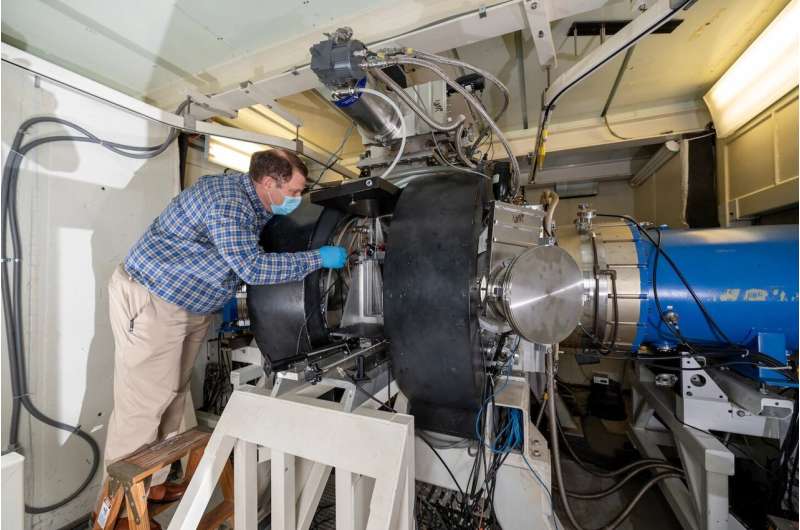Credit: Naval Research Laboratory
U.S. Naval Research Laboratory experts race toward sustainable clean energy with advances in fusion energy. Steve Obenschain, Ph.D., a research physicist at NRL, said nuclear fusion would be a valuable addition to clean energy sources because it can provide baseload electrical power when the sun does not shine and the wind does not blow. The baseload is the minimum level of demand on an electrical grid over a span of time, for example, one week.
Scientists at NRL, in collaboration with the U.S. Department of Energy, published their Argon fluoride (ArF) laser fusion research findings in the Philosophical Transactions of the Royal Society last fall.
The scientific paper, "Direct drive with the argon fluoride laser as a path to high fusion gain with sub-megajoule laser energy," reports ArF is a promising technology for achieving the high-gain inertial fusion implosions needed for energy production. Laser fusion involves the implosion of small capsules to achieve the high densities and temperatures (100 million degrees Celsius) required to initiate the fusion reactions.
If the fusion energy gain is much larger than that required to power the laser, one can use this as a power source. NRL simulations indicate ArF's deep ultraviolet light could enable high gain at much lower laser energy than previously thought feasible.
"The ArF laser could enable development and construction of much smaller, lower cost fusion power plants," Obenschain said. "This would hasten the deployment of this attractive power source with enough fuel feedstock readily available to last thousands of years."
The NRL result is particularly important because the Lawrence Livermore National Laboratory National Ignition Facility (NIF) announced Aug. 8 it had performed a laser fusion experiment that yielded almost as much fusion energy as that of the laser beams used to drive the implosion. The NIF result yielded 1.3 mega joules of fusion energy, equivalent to one pound of high explosive, thereby demonstrating the basic scientific and technical feasibility of laser fusion.
"The NIF result is impressive and highlights the need to look ahead to what laser technologies will accelerate future progress. The NRL ArF laser technology provides a path to much higher fusion gain and yields," Obenschain said. "These qualities are needed for the National Nuclear Security Administration's stockpile stewardship program and the high gain is needed for fusion power."
The Nike laser lens array focuses 44 krypton-fluoride (KrF) laser beams onto targets that represent a small portion of an imploding capsule. The mm-size target is visible in the center lens. The KrF laser is similar to ArF but has somewhat longer wavelength (248 nm). The Nike experiments advance the basic physics for uniformly accelerating targets to the high velocities needed for fusion implosions. Credit: Naval Research Laboratory
High-energy ArF lasers will require a significant investment to reach the performance required for fusion and the energy, repetition rate, precision and billion-shot class reliability necessary for a commercial power plant, Obenschain noted.
"Our work so far indicates there is no fundamental obstacle preventing an ArF direct-drive inertial fusion energy system from meeting these requirements," Obenschain said.
"The advantages could facilitate the development of modest size, less expensive fusion power plant modules operating at laser energies less than 1 mega joule," he said. "That would drastically change the existing view on laser fusion energy being too expensive and power plants being too large."
"NRL is the world leader in the development of high energy Argon fluoride laser technology," said Max Karasik, Ph.D., head of NRL's Laser Driven Targets Physics Section "In addition we conduct experiments to advance the physics underpinnings of laser fusion and computer simulations to determine the optimum configurations to obtain high-gain implosions with the ArF laser."
This potential of the ArF laser for fusion energy has generated support by the DoE Advanced Research Projects Agency-Energy (ARPA-E) Breakthroughs Enabling Thermonuclear-fusion Energy (BETHE) program. The program supports the development of timely, commercially viable fusion energy.
The laser plasma Branch in the Plasma Physics Division is leading this research effort and has developed a 3-phase plan to advance the argon-fluoride laser to performance needed for high-energy-gain implosions.
The first phase would complete the basic science and technology of the ArF now underway at NRL. In the second phase, a full-scale high-energy ArF laser beamline would be constructed and tested. In the third phase an implosion facility would be constructed from twenty to thirty of these beamlines and utilized to demonstrate the high-energy gains (>100) needed for both defense and energy applications.
Peter Matic, Ph.D., Associate Director of Research for the Materials Science and Component Technology Directorate, said, "This work is exciting. As we move forward, we would welcome collaboration with other laboratories, universities and the private sector to advance this potentially game changing approach to accelerate progress in the quest for laser fusion."
More information: S. P. Obenschain et al, Direct drive with the argon fluoride laser as a path to high fusion gain with sub-megajoule laser energy, Philosophical Transactions of the Royal Society A: Mathematical, Physical and Engineering Sciences (2020). DOI: 10.1098/rsta.2020.0031
Journal information: Philosophical Transactions of the Royal Society
Provided by Naval Research Laboratory

























